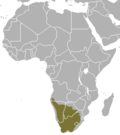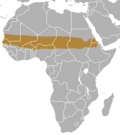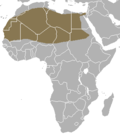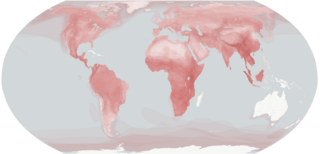
Carnivora is an order of placental mammals that have specialized in primarily eating flesh, whose members are formally referred to as carnivorans. The order Carnivora is the fifth largest order of mammals, comprising at least 279 species.

Canidae is a biological family of dog-like carnivorans, colloquially referred to as dogs, and constitutes a clade. A member of this family is also called a canid. The family includes three subfamilies: the Caninae, the extinct Borophaginae and Hesperocyoninae. The Caninae are known as canines, and include domestic dogs, wolves, coyotes, foxes, jackals and other species.

Foxes are small- to medium-sized omnivorous mammals belonging to several genera of the family Canidae. They have a flattened skull; upright, triangular ears; a pointed, slightly upturned snout; and a long, bushy tail ("brush").

The fennec fox is a small crepuscular fox native to the deserts of North Africa, ranging from Western Sahara and Mauritania to the Sinai Peninsula. Its most distinctive feature is its unusually large ears, which serve to dissipate heat and listen for underground prey. The fennec is the smallest fox species. Its coat, ears, and kidney functions have adapted to the desert environment with high temperatures and little water. It mainly eats insects, small mammals and birds. The fennec has a life span of up to 14 years in captivity and about 10 years in the wild. Its main predators are the Verreaux's eagle-owl, jackals and other large mammals. Fennec families dig out burrows in the sand for habitation and protection, which can be as large as 120 m2 (1,300 sq ft) and adjoin the burrows of other families. Precise population figures are not known but are estimated from the frequency of sightings; these indicate that the fennec is currently not threatened by extinction. Knowledge of social interactions is limited to information gathered from captive animals. The fennec's fur is prized by the indigenous peoples of North Africa, and it is considered an exotic pet in some parts of the world.

The bat-eared fox is a species of fox found on the African savanna. It is the only extant species of the genus Otocyon and considered a basal canid species. Fossil records indicate this canid first appeared during the middle Pleistocene.

Canis is a genus of the Caninae which includes multiple extant species, such as wolves, dogs, coyotes, and golden jackals. Species of this genus are distinguished by their moderate to large size, their massive, well-developed skulls and dentition, long legs, and comparatively short ears and tails.

The Cape fox, also called the asse, cama fox or the silver-backed fox, is a small species of fox, native to southern Africa. It is also called a South African version of a fennec fox due to its similarly big ears. It is the only "true fox" occurring in sub-Saharan Africa, and it retains primitive characteristics of Vulpes because it diverged early in the evolutionary history of the group.

The South American foxes (Lycalopex), commonly called raposa in Portuguese, or zorro in Spanish, are a genus from South America of the subfamily Caninae. Despite their name, they are not true foxes, but are a unique canid genus more closely related to wolves and jackals than to true foxes; some of them resemble foxes due to convergent evolution. The South American gray fox, Lycalopex griseus, is the most common species, and is known for its large ears and a highly marketable, russet-fringed pelt.

Caniformia is a suborder within the order Carnivora consisting of "dog-like" carnivorans. They include dogs, bears, raccoons, and mustelids. The Pinnipedia are also assigned to this group. The center of diversification for the Caniformia is North America and northern Eurasia. Caniformia stands in contrast to the other suborder of Carnivora, the Feliformia, the center of diversification of which was in Africa and southern Asia.
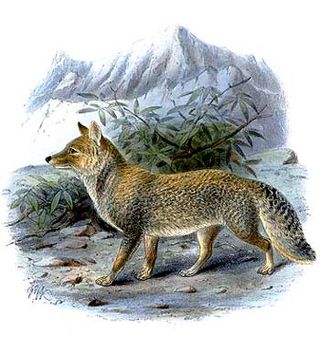
The Tibetan fox, also known as the Tibetan sand fox, is a species of true fox endemic to the high Tibetan Plateau, Ladakh plateau, Nepal, China, Sikkim, and Bhutan, up to elevations of about 5,300 m (17,400 ft). It is listed as Least Concern in the IUCN Red List, on account of its widespread range in the Tibetan Plateau's steppes and semi-deserts.

Blanford's fox is a small fox native to the Middle East and Central Asia. It is listed as Least Concern on the IUCN Red List.

The Sechuran fox, also called the Peruvian desert fox or the Sechuran zorro, is a small South American species of canid closely related to other South American "false" foxes or zorro. It gets its name for being found in the Sechura Desert in northwestern Peru.
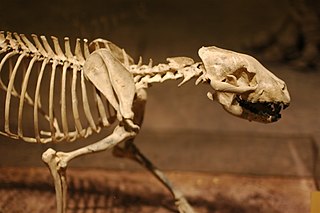
The extinct Borophaginae form one of three subfamilies found within the canid family. The other two canid subfamilies are the extinct Hesperocyoninae and extant Caninae. Borophaginae, called "bone-crushing dogs", were endemic to North America during the Oligocene to Pliocene and lived roughly 34—2.5 million years ago, existing for about 33.5 million years.
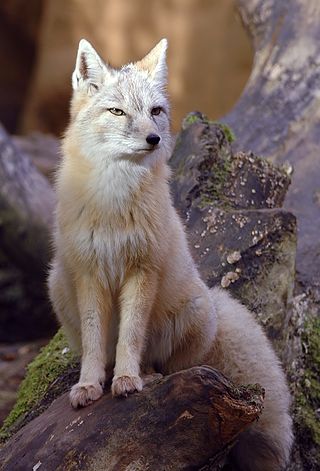
The corsac fox, also known simply as a corsac, is a medium-sized fox found in steppes, semi-deserts and deserts in Central Asia, ranging into Mongolia and northern China. Since 2004, it has been classified as least concern by IUCN, but populations fluctuate significantly, and numbers can drop tenfold within a single year. It is also known as the steppe fox. The word "corsac" is derived from the Russian name for the animal, "korsák" (корса́к), derived ultimately from Turkic "karsak".
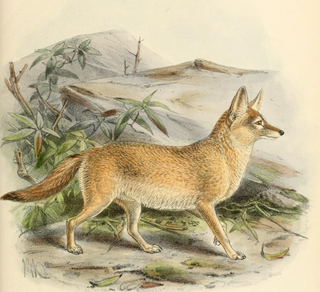
The pale fox is a species of fox found in the band of African Sahel from Senegal in the west to Sudan in the east. It is one of the least studied of all canid species, in part due to its remote habitat and its sandy coat that blends in well with the desert-like terrain. The pale fox is distinguished by its light-colored fur and oversized ears, which enable it to excel in camouflage and survival in harsh environments.

Rüppell's fox, also called Rüppell's sand fox, is a fox species living in desert and semi-desert regions of North Africa, the Middle East, and southwestern Asia. It has been listed as Least Concern on the IUCN Red List since 2008. It is named after the German naturalist Eduard Rüppell.

The Caninae, known as canines, are one of three subfamilies found within the canid family. The other two canid subfamilies are the extinct Borophaginae and Hesperocyoninae. The Caninae includes all living canids and their most recent fossil relatives. Their fossils were first found in North America and dated to the Oligocene era, then spreading to Asia at the end of the Miocene era, some 7 million to 8 million years ago.

The red fox is the largest of the true foxes and one of the most widely distributed members of the order Carnivora, being present across the entire Northern Hemisphere including most of North America, Europe and Asia, plus parts of North Africa. It is listed as least concern on the IUCN Red List. Its range has increased alongside human expansion, having been introduced to Australia, where it is considered harmful to native mammals and bird populations. Due to its presence in Australia, it is included on the list of the "world's 100 worst invasive species".

Cerdocyonina is an extant subtribe of the canines and is exclusively endemic to the Americas. Often described to be "fox-like" in appearance and behavior, they are more closely related to the wolf-like canids such as Canis than they are to the fox genus Vulpes. Its members are colloquially known as the South American canids and there are 10 extant species. They are sometimes referred to as South American foxes in the older literature, but the term zorro has been recommended by mammalogists to avoid confusion with the true foxes of the tribe Vulpini, which includes the genus Vulpes.






